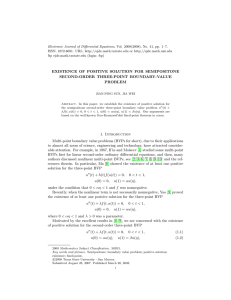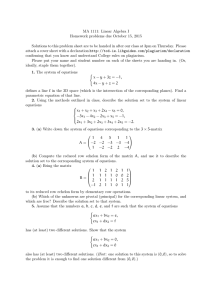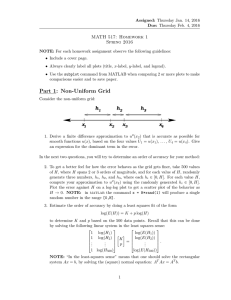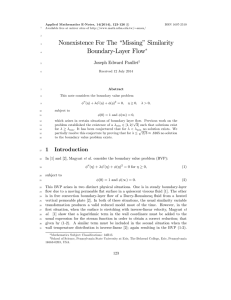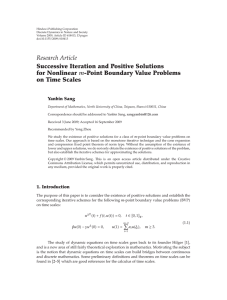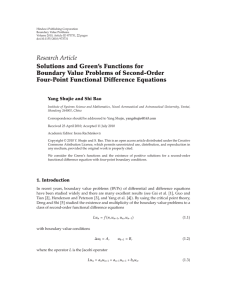Document 10841104
advertisement
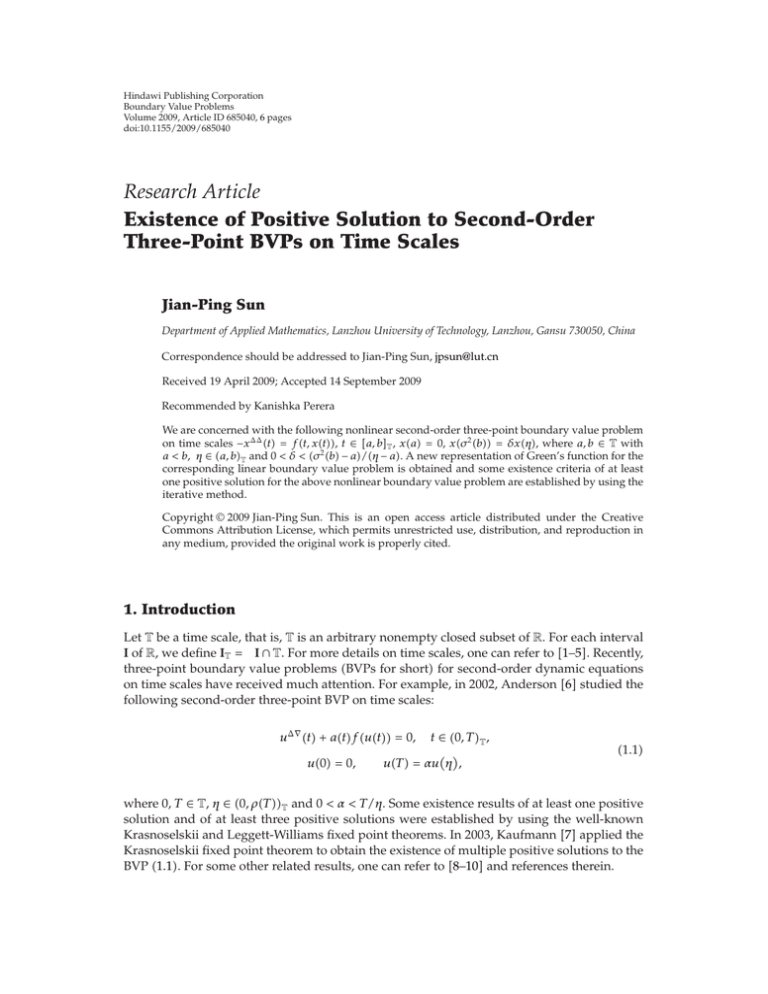
Hindawi Publishing Corporation
Boundary Value Problems
Volume 2009, Article ID 685040, 6 pages
doi:10.1155/2009/685040
Research Article
Existence of Positive Solution to Second-Order
Three-Point BVPs on Time Scales
Jian-Ping Sun
Department of Applied Mathematics, Lanzhou University of Technology, Lanzhou, Gansu 730050, China
Correspondence should be addressed to Jian-Ping Sun, jpsun@lut.cn
Received 19 April 2009; Accepted 14 September 2009
Recommended by Kanishka Perera
We are concerned with the following nonlinear second-order three-point boundary value problem
on time scales −xΔΔ t ft, xt, t ∈ a, bT , xa 0, xσ 2 b δxη, where a, b ∈ T with
a < b, η ∈ a, bT and 0 < δ < σ 2 b − a/η − a. A new representation of Green’s function for the
corresponding linear boundary value problem is obtained and some existence criteria of at least
one positive solution for the above nonlinear boundary value problem are established by using the
iterative method.
Copyright q 2009 Jian-Ping Sun. This is an open access article distributed under the Creative
Commons Attribution License, which permits unrestricted use, distribution, and reproduction in
any medium, provided the original work is properly cited.
1. Introduction
Let T be a time scale, that is, T is an arbitrary nonempty closed subset of R. For each interval
I of R, we define IT I ∩ T. For more details on time scales, one can refer to 1–5. Recently,
three-point boundary value problems BVPs for short for second-order dynamic equations
on time scales have received much attention. For example, in 2002, Anderson 6 studied the
following second-order three-point BVP on time scales:
uΔ∇ t atfut 0,
u0 0,
t ∈ 0, T T ,
uT αu η ,
1.1
where 0, T ∈ T, η ∈ 0, ρT T and 0 < α < T/η. Some existence results of at least one positive
solution and of at least three positive solutions were established by using the well-known
Krasnoselskii and Leggett-Williams fixed point theorems. In 2003, Kaufmann 7 applied the
Krasnoselskii fixed point theorem to obtain the existence of multiple positive solutions to the
BVP 1.1. For some other related results, one can refer to 8–10 and references therein.
2
Boundary Value Problems
In this paper, we are concerned with the existence of at least one positive solution for
the following second-order three-point BVP on time scales:
− xΔΔ t ft, xt, t ∈ a, bT ,
xa 0,
x σ 2 b δx η .
1.2
Throughout this paper, we always assume that a, b ∈ T with a < b, η ∈ a, bT , and 0 < δ <
σ 2 b − a/η − a.
It is interesting that the method used in this paper is completely different from that in
6, 7, 9, 10, that is, a new representation of Green’s function for the corresponding linear BVP
is obtained and some existence criteria of at least one positive solution to the BVP 1.2 are
established by using the iterative method.
For the function f, we impose the following hypotheses:
H1 f : a, bT × R → R is continuous;
H2 for fixed t ∈ a, bT , ft, u is monotone increasing on u;
H3 there exists q ∈ 0, 1 such that
ft, ru ≥ r q ft, u
for r ∈ 0, 1, t, u ∈ a, bT × R .
1.3
for λ ∈ 1, ∞, t, u ∈ a, bT × R .
1.4
Remark 1.1. If H3 is satisfied, then
ft, λu ≤ λq ft, u
2. Main Results
Lemma 2.1. The BVP 1.2 is equivalent to the integral equation
xt σb
a
Kt, sfs, xsΔs,
t ∈ a, σ 2 b ,
T
2.1
where
δG η, s
Kt, s Gt, s 2
t − a
σ b − a − δ η − a
2.2
is called the Green’s function for the corresponding linear BVP, here
⎧
⎨t − a σ 2 b − σs ,
1
Gt, s 2
σ b − a ⎩σs − aσ 2 b − t,
t ≤ s,
t ≥ σs
2.3
Boundary Value Problems
3
is the Green’s function for the BVP:
−xΔΔ t 0, t ∈ a, bT ,
xa x σ 2 b 0.
2.4
Proof. Let x∗ be a solution of the BVP:
−xΔΔ t ft, xt, t ∈ a, bT ,
xa x σ 2 b 0.
2.5
Then, it is easy to know that
x∗ t σb
a
Gt, sfs, xsΔs,
t ∈ a, σ 2 b ,
T
x∗ a x∗ σ 2 b 0.
2.6
Now, if x is a solution of the BVP 1.2, then it can be expressed by
xt C1 C2 t x∗ t,
2.7
which together with the boundary conditions in 1.2 and 2.6 implies that
δx∗ η
t − a x∗ t
σ 2 b − a − δ η − a
σb
Kt, sfs, xsΔs, t ∈ a, σ 2 b .
xt 2.8
T
a
On the other hand, if x satisfies 2.1, then it is easy to verify that x is a solution of the
BVP 1.2.
Lemma 2.2. For any t, s ∈ a, σ 2 bT × a, σbT , one has
δG η, s
δG η, s
t − a ≤ Kt, s ≤ 1 2
t − a.
σ 2 b − a − δ η − a
σ b − a − δ η − a
2.9
Proof. Since it is obvious from the expression of Gt, s that
0 ≤ Gt, s ≤
1
σ 2 b
−a
t − a σ 2 b − t ,
we know that 2.9 is fulfilled.
t, s ∈ a, σ 2 b × a, σbT ,
T
2.10
4
Boundary Value Problems
Our main result is the following theorem.
Theorem 2.3. Assume that (H1)–(H3) are satisfied. Then, the BVP 1.2 has at least one positive
solution w. Furthermore, there exist M ≥ m > 0 such that
mt − a ≤ wt ≤ Mt − a,
t ∈ a, σ 2 b .
2.11
T
Proof. Let
E x | x : a, σ 2 b −→ R is continuous ,
T
D x ∈ E | there exist Mx ≥ mx > 0 such that mx t−a ≤ xt ≤ Mx t−a for t ∈ a, σ 2 b
,
T
P x ∈ E | xt ≥ 0 for t ∈ a, σ 2 b
.
T
2.12
Define an operator F : D → P :
Fxt σb
a
Kt, sfs, xsΔs,
t ∈ a, σ 2 b .
2.13
T
Then it is obvious that fixed points of the operator F in D are positive solutions of the BVP
1.2.
First, in view of H2, it is easy to know that F : D → P is increasing.
Next, we may assert that F : D → D, which implies that for any x ∈ D, there exist
positive constants l and L such that
Fxt ≤ Lxt,
Fxt ≥ lxt for x ∈ a, σ 2 b .
T
2.14
In fact, for any x ∈ D, there exist 0 < mx < 1 < Mx such that
mx t − a ≤ xt ≤ Mx t − a for t ∈ a, σ 2 b ,
T
2.15
which together with H2, H3, and Remark 1.1 implies that
mx q ft, t − a ≤ ft, xt ≤ Mx q ft, t − a
for t ∈ a, bT .
2.16
By Lemma 2.2 and 2.16, for any t ∈ a, σ 2 bT , we have
σb δG η, s
1 2
fs, s − aΔst − a,
Fxt ≤ Mx σ b − a − δ η − a
a
σb
δG η, s
q
fs, s − aΔst − a.
Fxt ≥ mx σ 2 b − a − δ η − a
a
q
2.17
Boundary Value Problems
5
If we let
σb 1
M0 Mx δG η, s
fs, s − aΔs,
σ 2 b − a − δ η − a
a
σb
δG η, s
m0 mx q
fs, s − aΔs,
σ 2 b − a − δ η − a
a
q
2.18
then it follows from 2.17 and 2.18 that
m0 t − a ≤ Fxt ≤ M0 t − a
for t ∈ a, σ 2 b ,
2.19
T
which shows that Fx ∈ D.
Now, for any fixed h0 ∈ D, we denote
lh0 sup l > 0 | Fh0 t ≥ lh0 t, t ∈ a, σ 2 b
2.20
Lh0 inf L > 0 | Fh0 t ≤ Lh0 t, t ∈ a, σ 2 b
2.21
T
m min
1
, lh0 1/1−q ,
2
T
M max 2, Lh0 1/1−q
2.22
and let
un t Fun−1 t,
vn t Fvn−1 t,
t ∈ a, σ 2 b , n 1, 2, . . . ,
2.23
t ∈ a, σ 2 b .
2.24
T
where
u0 t mh0 t,
v0 t Mh0 t,
T
Then, it is easy to know from 2.20, 2.21, 2.22, 2.23, 2.24, H3, and Remark 1.1 that
u0 t ≤ u1 t ≤ · · · ≤ un t ≤ · · · ≤ vn t ≤ · · · ≤ v1 t ≤ v0 t,
t ∈ a, σ 2 b .
T
2.25
Moreover, if we let t0 m/M, then it follows from 2.22, 2.23, 2.24, and H3 by induction
that
n
un t ≥ t0 q vn t,
t ∈ a, σ 2 b , n 0, 1, 2, . . . ,
2.26
T
which together with 2.25 implies that for any positive integers n and p,
n
0 ≤ unp t − un t ≤ 1 − t0 q Mh0 t,
t ∈ a, σ 2 b .
T
2.27
6
Boundary Value Problems
∞
Therefore, there exists a w ∈ D such that {un t}∞
n0 and {vn t}n0 converge uniformly to w
2
on a, σ bT and
un t ≤ wt ≤ vn t,
t ∈ a, σ 2 b , n 0, 1, 2, . . . .
T
2.28
Since F is increasing, in view of 2.28, we have
un1 t Fun t ≤ Fwt ≤ Fvn t vn1 t,
t ∈ a, σ 2 b , n 0, 1, 2, . . . .
T
2.29
So,
Fwt wt,
t ∈ a, σ 2 b ,
2.30
T
which shows that w is a positive solution of the BVP 1.2. Furthermore, since w ∈ D, there
exist M ≥ m > 0 such that
mt − a ≤ wt ≤ Mt − a,
t ∈ a, σ 2 b .
T
2.31
Acknowledgment
This work is supported by the National Natural Science Foundation of China 10801068.
References
1 R. P. Agarwal and M. Bohner, “Basic calculus on time scales and some of its applications,” Results in
Mathematics, vol. 35, no. 1-2, pp. 3–22, 1999.
2 M. Bohner and A. Peterson, Dynamic Equations on Time Scales: An Introduction with Application,
Birkhäuser, Boston, Mass, USA, 2001.
3 M. Bohner and A. Peterson, Advances in Dynamic Equations on Time Scales, Birkhäuser, Boston, Mass,
USA, 2003.
4 S. Hilger, “Analysis on measure chains—a unified approach to continuous and discrete calculus,”
Results in Mathematics, vol. 18, no. 1-2, pp. 18–56, 1990.
5 V. Lakshmikantham, S. Sivasundaram, and B. Kaymakcalan, Dynamic Systems on Measure Chains, vol.
370 of Mathematics and Its Applications, Kluwer Academic Publishers, Dordrecht, The Netherlands,
1996.
6 D. R. Anderson, “Solutions to second-order three-point problems on time scales,” Journal of Difference
Equations and Applications, vol. 8, no. 8, pp. 673–688, 2002.
7 E. R. Kaufmann, “Positive solutions of a three-point boundary-value problem on a time scale,”
Electronic Journal of Differential Equations, vol. 2003, no. 82, 11 pages, 2003.
8 R. A. Khan, J. J. Nieto, and V. Otero-Espinar, “Existence and approximation of solution of three-point
boundary value problems on time scales,” Journal of Difference Equations and Applications, vol. 14, no.
7, pp. 723–736, 2008.
9 H. Luo and Q. Ma, “Positive solutions to a generalized second-order three-point boundary-value
problem on time scales,” Electronic Journal of Differential Equations, vol. 2005, no. 17, 14 pages, 2005.
10 H.-R. Sun and W.-T. Li, “Positive solutions for nonlinear three-point boundary value problems on
time scales,” Journal of Mathematical Analysis and Applications, vol. 299, no. 2, pp. 508–524, 2004.

